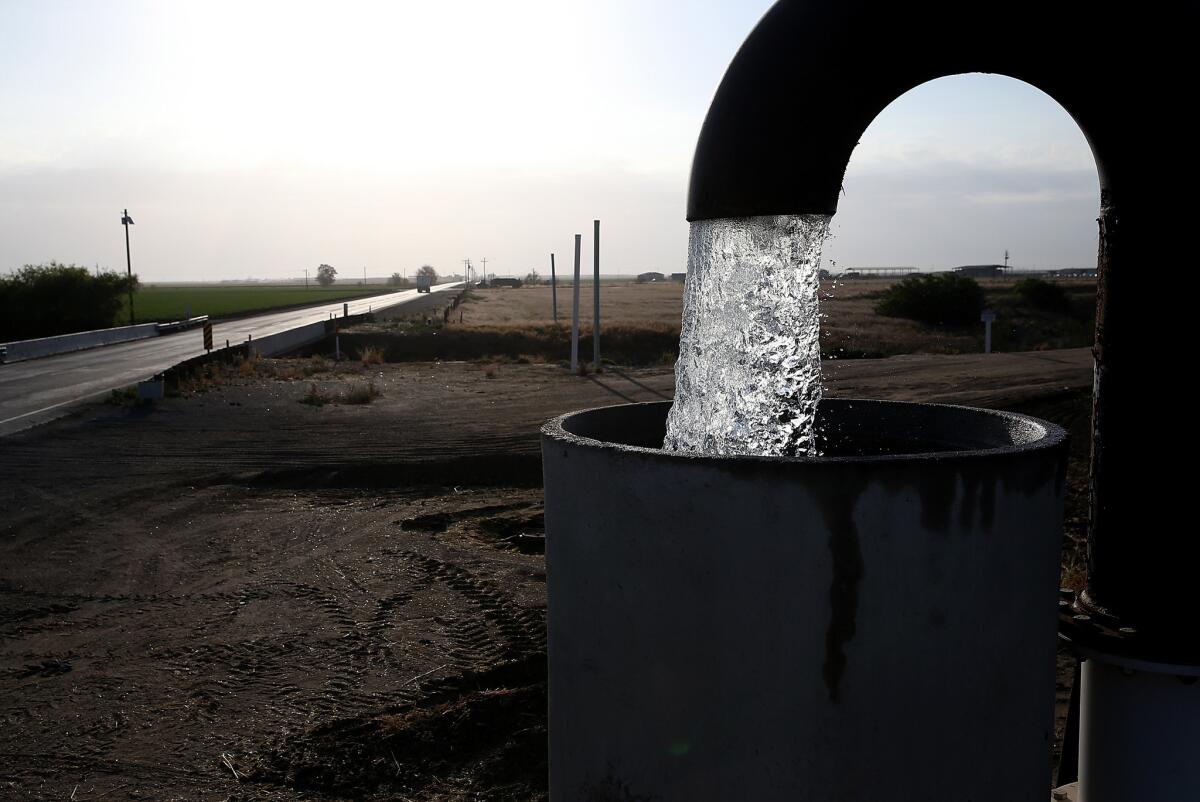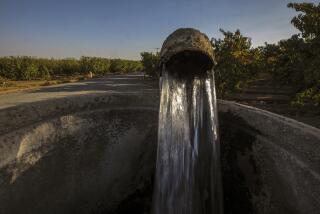Natural impurities exceed human-made ones in state groundwater, study finds

Well water is pumped from the ground in Tulare, Calif., in April.
A decade-long federal survey has concluded that natural contaminants are more prevalent than human-made contaminants in California groundwater aquifers used for public consumption.
The U.S. Geological Survey analysis of 11,000 public wells in 87 study areas determined that natural contaminants such as arsenic and uranium occur at high concentrations in about 20% of the groundwater used for public supply.
Human-made contaminants such as nitrate and organic solvents occur at high concentrations in about 5% of the resources.
Although human-made contaminants do not show up as often, they are found in groundwater aquifers supplying drinking water to millions of residents in Southern California, said Kenneth Belitz, who led the $50-million study recently published in the peer-reviewed journal Environmental Science & Technology.
“This is the most comprehensive study of groundwater contamination conducted by any state in the nation,” Belitz said in an interview Thursday. “It tells us which contaminants are most important and where they are.”
Areas of particular concern, he said, include the Santa Ana Basin and the San Gabriel and San Fernando valleys, where nitrates and organic solvent compounds occur over a relatively large proportion of their groundwater aquifers.
The industrial solvent trichloroethylene – one of the most widespread groundwater contaminants in California and across the nation – has been linked to kidney and liver cancer and other health problems. High concentrations of nitrate have been associated with a life-threatening condition in infants known as “blue baby syndrome.”
“Also notable were the desert areas in east San Bernardino County,” Belitz said, “because 30% of the public supplies of groundwater out there show high concentrations of naturally occurring trace elements such as arsenic and uranium.”
The study, commissioned by the California State Water Board’s Groundwater Ambient Monitoring and Assessment Program, focused on nearly 200 natural and human-made contaminants typically found in untreated groundwater -- the source of about one-third of the drinking water consumed annually in California.
Unlike previous assessments, which focused on contaminants in specific aquifers, the USGS evaluated a range of resources and the population centers affected. The approach, he said, could help water providers, regulatory authorities and policy makers relate groundwater quality to health outcomes.
That hasn’t been easy. The Los Angeles metropolitan area, for example, overlies a checkerboard of underground plumes of trichloroethylene, and has high levels of the chemical in the air. More than 30 square miles of the San Gabriel Valley lie in one of four Superfund sites that contain TCE. The San Fernando Valley overlies a large plume grouped into three separate Superfund sites. The former Marine Corps Air Station in El Toro in Orange County sits over plumes several miles long.
“Overall, this study shows that for too long California has treated groundwater as out of sight, out of mind,” Briana Mordick, a staff scientists at the Natural resources Defense Council, said.
“So, we have a long way to go when it comes to protecting groundwater,” Mordick said. “Yet, in times of drought, Californians increasingly turn to groundwater supplies.”
Follow me @LouisSahagun for more fascinating stories







